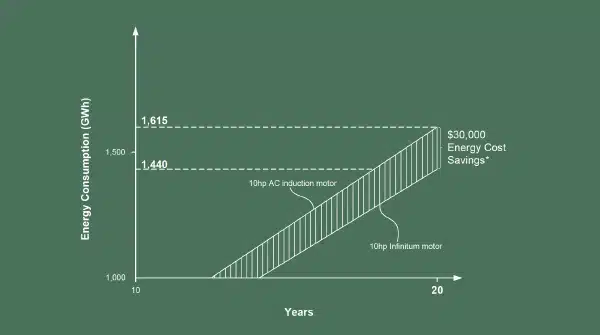Evaluating Sustainability Claims of Electric Motors
There’s no disputing it. Every company should prioritize mindful stewardship of natural resources, including those of us in the industrial sector. To help us do that, we need standards and methodologies that can help us assess the life cycle of the products we deploy. With more knowledge, we can look for ways to lower emissions.
One industry that’s championed standards development and implementation is building and construction. Leadership in Energy and Environmental Design (LEED), the WELL Building Standard, the Living Building Challenge, and Energy Star are comprehensive certifications that account for a building’s lifecycle including, but not limited to, energy, lighting, acoustics, materials and site management. Some existing certifications, like the Living Building Challenge, go beyond reducing footprint. They demand that a building has a net positive impact.
Each of these certifications feature methodologies to assess carbon footprint. For example, LEED includes whole-building life cycle assessment (LCA)—a quantitative approach to comparing the environmental impacts of the products, processes and systems that go into constructing and maintaining a building. While these certifications aren’t perfect solutions, they establish a framework for the building and construction industry to better understand the impact of their work and act on behalf of the environment.
Industrial products and processes are starting to leverage LCA methodologies too. Rochester Institute of Technology defines an industrial LCA as “a systematic analysis of environmental impact over the course of the entire life cycle of a product, material, process, or other measurable activity.” They identify a linear production model that includes:
-
- Material extraction
-
- Production
-
- Packaging and distribution
-
- Use
-
- End of use and waste treatment / recovery, which we’ll refer to as end of life (EOL)
Infinitum is starting down the path to identify baselines for motor production and operation because we believe that once we understand where we are, we can make better decisions on how to improve. Here’s how we’re starting to create a methodology and establish benchmarks.
Making the Infinitum Motor
To start, we’re using information about the procurement and refinement of the materials used in our electric motors as a proxy for the carbon footprint that results from making them. Over time, we aim to be able to assess the production, packaging and delivery processes as well.
The most common materials used in motor manufacturing are copper, iron/steel, aluminum and, sometimes, magnets. Unlike other motors, Infinitum also leverages printed circuit boards (PCBs). Each of these materials is assigned an emissions factor that indicates how much energy it takes to transform from a raw material to its fabrication-ready form.
From a materials standpoint, Infinitum motor emissions are estimated by multiplying the embodied energy (MJ/kg) of each individual material in the motor by its emissions factor. The same process is repeated for a baseline 10HP AC induction motor[1] for a point of comparison. Emissions are calculated based on type and quantity of materials used, and all emissions are measured in quantity of CO2. Our current methodology shows an overall CO2 reduction of 18 percent for a 10HP Infinitum motor[2] compared to a traditional 10HP AC induction motor (Figure 1). 75 percent of the aluminum Infinitum uses for motor housings is recycled material, and in this methodology, we assume the reference motor uses the same ratio.

Figure 1: Infinitum’s methodology shows an overall CO2 reduction of 18 percent for a 10HP Infinitum motor2 compared to a traditional 10HP AC induction motor. Key assumptions listed at the end of the page.
Running the Infinitum Motor
With our current methodology, energy consumption during operation is based on standards and published numbers. Energy consumption is based on power, operating time and the efficiency of the motor + VFD. For the sake of comparison, the same calculation is performed for a 10HP AC induction motor + VFD with IE1 efficiency.
For this calculation, emissions avoided from energy consumption are considered for both motor systems[1] over a 20-year period, and the cost of energy is estimated using U.S. Bureau of Labor statistics. The Infinitum motor system was found to produce 10 percent fewer CO2 emissions in operation.
In a practical example, over a period of 20 years, a 10HP AC induction motor + VFD uses 1,615 Gigawatt-hours (GWh) of energy while a 10HP Infinitum motor system uses 1,440 Gigawatt-hours (GWh). In this scenario energy cost savings amount to $30,000 (Figure 2). Over 20 years, every 100,000 Infinitum motors in service reduces CO2 emissions by 8 million metric tons. That’s the equivalent of pulling 1.5 million homes off the grid for a year.

Figure 2: In a practical example, over 20 years, a 10HP Infinitum motor system uses 1,440 Gigawatt-hours (GWh). This amounts to an energy cost savings of $30,000 compared to a 10HP AC induction motor + VFD.
It’s worth noting that there are a couple of well-known efficiency standards in the industrial space today. Standard IEC/EN 60034-30-1 and the National Electrical Manufacturers Association (NEMA) are typically used to compare one motor to another in terms of operational energy use. IEC, spanning from IE1 to IE5, focuses on application-specific performance. NEMA, spanning from “standard efficiency” to “super premium,” rewards motor designs with broader applicability across applications.
Managing End of Life (EOL) for the Infinitum Motor
At the end of a motor’s operational life, there are three main options: landfill, recycling of materials or remanufacturing (i.e., reuse of components). Infinitum motor components can be reused, so in each generation of manufacturing, CO2 reduction compounds, resulting in a 59 percent CO2 reduction for the second-generation Infinitum motor compared to the second generation 10HP AC induction motor (Figure 3). Assuming a useful lifetime of 10 years for a conventional 10HP AC induction motor, in 20 years, the conventional motor will have been manufactured twice. In the same amount of time, an Infinitum motor can be manufactured once and remanufactured from reused components. Our current methodology accounts for landfill and remanufacturing. Recycling materials like steel can save energy; however, we can’t confirm that recycled material is used to make the next motor, so that scenario has been omitted.

Figure 3: Infinitum’s methodology shows that CO2 reduction compounds, resulting in a 59 percent CO2 reduction for the second-generation Infinitum motor compared to the 10HP AC induction motor, which has to be manufactured from scratch both times. Key assumptions listed at the end of the page.
Matters of Methodology
The capacity to compare motors objectively is important. We need to explore the materials used in the motor, the manufacturing processes that turn those materials into components, the assembly process, transportation and distribution, operation and end of life (EOL). As we gain a better understanding of lifecycle emissions, we’ll be able to make informed decisions at each phase in a motor’s life and compare motors more holistically. At Infinitum we’ve begun this journey by measuring and benchmarking several of those methodology process steps.
In 2023, Sustainalytics, a Morningstar Company evaluated our methodology and deemed it “good practice” for impact reporting. We’re committed to making meaningful assessments and finding ways to improve.
Electric motors serve a variety of industries and functions, including HVAC operations where our LCA overlaps with the building and construction industry. Understanding how a well-designed motor can contribute positively to existing and emerging environmental certifications is important to us. By working with Infinitum, customers have access to state-of-the-art motors, but they also gain a sustainability partner for life. We’re always looking for ways to hold ourselves to a higher standard.
For further information on how to reduce the energy requirements of a motor, see How to Exceed Customer Expectations by Rightsizing the Motor for Your Fan System. For more information about how Infinitum can deliver sustainable motors for your application, reach out to our engineering team.
Key assumptions for Carbon Footprint Comparison
-
- Motor compares are for 10 HP – 1800 configurations
-
- AC induction motor weighs 85kg. Infinitum motor weighs 45kg. No VFD
-
- Aluminum for both motors is assumed to be 75% recycled
-
- Useful lifetime for motors assumed = 10 years
